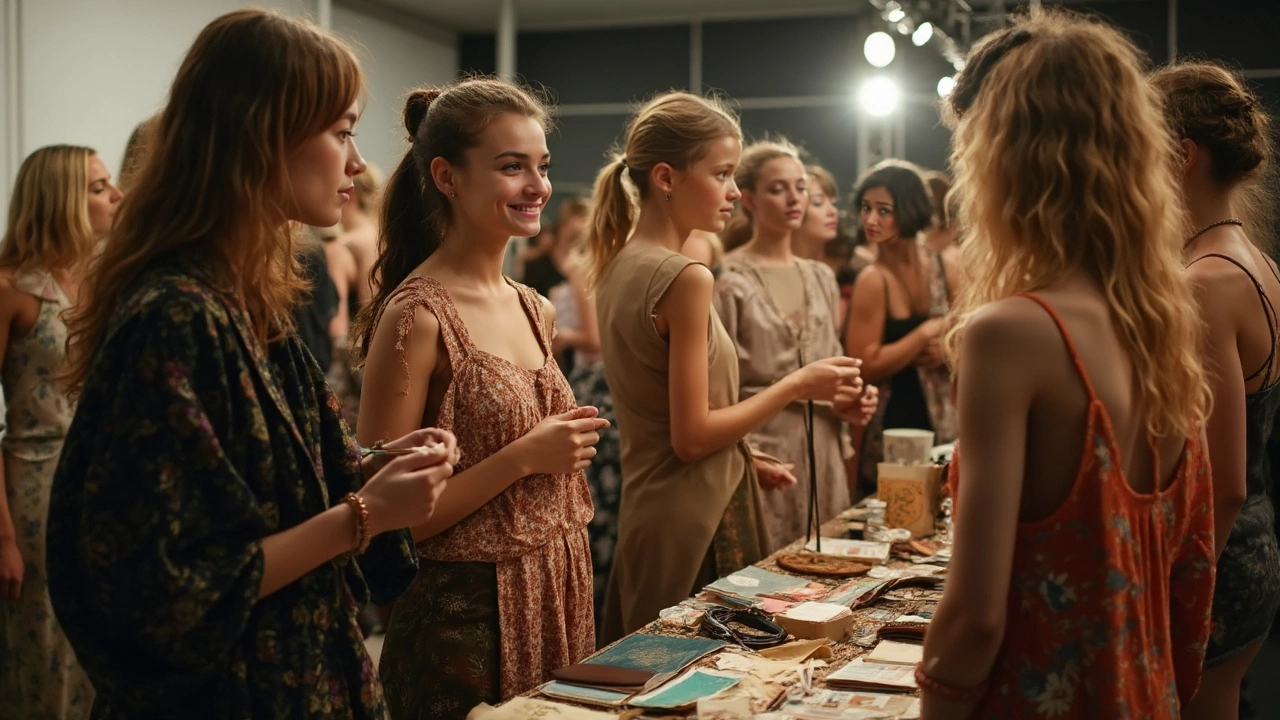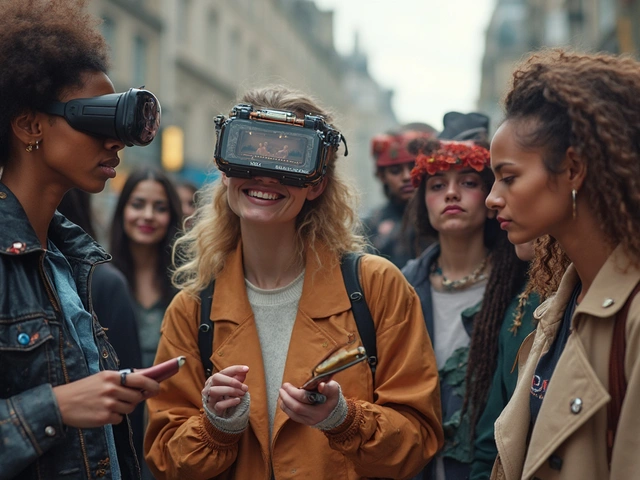Teen models aren’t just posing for selfies or strutting for the latest big brands. All across TikTok, Instagram, and the biggest runways, teens are giving sustainable fashion a major glow up. You’ve probably seen it—recycled fabric streetwear, upcycled thrifted outfits, and Instagram stories calling out brands that greenwash. If you’re a teen or know one (my kids, Zander and Lyla, are all over this trend), you’ve got front row seats to something pretty cool: a new generation that actually cares about what’s in their closet—and where it came from.
The best part? You don’t need a model contract to make a difference. Even the smallest swap—like grabbing a shirt made from organic cotton instead of regular, or reusing old jeans—adds up. Brands are seeing that youth voices matter, and some are even handing over their marketing to teen models who are down to talk about the real issues, not just what’s trending. Why’s this shift happening? Teens today know the impact of fashion on the planet and don’t want their looks costing the earth.
- Key Takeaways: Teen Models & Sustainable Fashion
- Why Teen Modeling Matters in Eco Fashion
- How Teens Are Leading the Change
- Tips for Teen Models & Parents: Going Green
- Comparing Sustainable vs. Fast Fashion for Teens
Key Takeaways: Teen Models & Sustainable Fashion
Here’s what you need to know about teen models and the sudden rise of sustainable fashion. This movement isn’t just about looking good—it’s about taking real action. Teens in modeling are actually changing the way brands and fans think about clothes, pushing for eco-friendly choices over fast fashion hype.
- Teen models are often the face of new sustainable fashion campaigns. Big eco-friendly brands like Stella McCartney and Patagonia have featured teen ambassadors to reach Gen Z shoppers who care about the planet.
- The buzz isn’t just for show. Reports from 2024 revealed that 60% of Gen Z, including most teen models, prefer wearing sustainable or upcycled clothing compared to older generations. These teens post about it, talk about it in castings, and expect brands to step up.
- Many teen models work with local designers making ethical clothes or even start their own thrift shop pop-ups. Events like “Model Swap” in NYC and “Teens for Green Fashion Week” in LA are grabbing headlines.
- Social media plays a gigantic role. When a teen model calls out a brand for greenwashing (fake eco claims), their followers listen. One viral TikTok video from a 17-year-old model led a major fast fashion retailer to announce new recycling targets last year.
- It’s not expensive to join in. More teens are swapping, renting, or DIY-ing their clothes instead of buying new. This trend makes sustainable fashion more accessible, so you don’t need a runway gig or big budget to help out.
| Gen Z vs. Millennials | Interest in Sustainable Fashion (%) |
|---|---|
| Gen Z (Age 13-24) | 60 |
| Millennials (Age 25-40) | 42 |
The bottom line? Teen models aren’t waiting for adults to save the world—they’re showing everyone how style and sustainability can go hand in hand. That’s why brands are paying close attention, and why these young influencers have the power to set fashion’s next big standard.
Why Teen Modeling Matters in Eco Fashion
Brands are catching on: teens are the most influential crowd in fashion right now, especially when it comes to sustainable fashion. Remember when it was all about celebrities? That feels old news. Now, it's young models who set trends and call out unsustainable habits—sometimes going viral for it. When a teen model shares an outfit from an eco-friendly fashion label or posts a video about upcycling, their audience listens. That reach can have more impact than some old-school ads ever did.
Many established brands, even big ones like Stella McCartney and Patagonia, often cast teen models to headline their green collections. Why? Because today's youth see right through fake advertising and want real commitments. Gen Z's top priorities? Authenticity and transparency. According to a 2024 survey by ThredUp, 62% of teens say they'd rather buy sustainable or secondhand clothing than fast fashion. That stat isn't just a blip—it’s a huge market shift.
Young models bring fresh ideas to the table, too. Instead of just wearing what brands give them, lots of them push for ethical sourcing, fair labor, and planet-friendly styles. For example, climate activist and teen model Xiye Bastida uses her platform to champion ethical brands while still keeping her fashion fun and relatable. Social media lets these teens turn even a small following into a megaphone for change.
- Eco-friendly fashion campaigns featuring teens can educate followers on what certifications or fabrics are actually sustainable.
- Teen models encourage their peers to question where their clothes come from—creating habits that last into adulthood.
- Youth-focused content often gets more shares and engagement than boring corporate posts, which helps the best eco-brands spread the word faster.
Bottom line: teen models aren't just here for the photos. They're shaping the conversation, making sure eco fashion is more than a trend—it’s the new normal.
| Teen Influence in Fashion (2024) | Percentage |
|---|---|
| Teens who follow sustainable fashion influencers | 68% |
| Teens who buy eco-friendly fashion monthly | 54% |
| Brands increasing teen-focused eco campaigns | 46% |

How Teens Are Leading the Change
Teen models have gone way beyond being just faces in lookbooks and ads. They’re pushing sustainable fashion into the spotlight, forcing brands to actually walk the talk. Take Kaia Gerber and Lily Chee for example—they show off eco-friendly lines on their feeds and even call out brands if something doesn’t add up. These teens know their platforms are powerful and aren’t afraid to use them.
What’s wild is how these young influencers team up with sustainable brands every day. Brands like Reformation, Stella McCartney, and even H&M’s Conscious line use real teens in campaigns to reach other teens who actually care about their impact. The message? It’s cool to make better choices. Zander showed me a TikTok not long ago where a model broke down the water it takes to make one regular t-shirt versus a recycled one—crazy stuff.
Social media is the biggest game changer. Teens are super quick to spot greenwashing, and they make sure everyone hears about it. They’ll tag brands, share their own thrifted outfits, or give behind-the-scenes looks into shoots using recycled props or ethical clothing. One scroll and you’ll see hundreds of posts with #sustainablefashion and #ecofriendlyfashion—both trending keywords that actually get people thinking about what they buy.
The data backs it up: According to a 2024 Statista survey, over 52% of Gen Z shoppers in the US say they’re willing to pay extra for clothes that are sustainable or ethically made. That’s a big deal, and brands can’t ignore it. Check out this quick look:
| Teens Surveyed | Willing to Pay More for Sustainable Fashion |
|---|---|
| Gen Z (US) | 52% |
| Millennials (US) | 34% |
What does all this mean for regular teens? You have more say than you think. Buying secondhand, supporting eco-friendly brands, or just talking about why it matters—these steps pile up. The more voices, the tougher it gets for fast fashion giants to ignore sustainability. If Zander and Lyla are any clue, these younger shoppers aren’t slowing down anytime soon.
Tips for Teen Models & Parents: Going Green
Diving into sustainable fashion as a teen model might feel tough at first, especially when fast fashion is everywhere and cheaper. But going green doesn’t mean spending a fortune or hunting for rare brands. Here’s how you and your parents can make better choices in real life, without stress.
- Swap Fast Fashion for Thrift Finds: Check out your local thrift stores or organized clothing swaps with friends. It’s one of the easiest ways to cut down on waste and develop a unique style. Sites like Depop and ThredUp are teen-friendly for online thrifting.
- Learn Materials Basics: Not all fabrics are equal. Organic cotton, bamboo, and TENCEL use less water and chemicals compared to regular cotton or polyester. If in doubt, scan the tag or look up the brand’s site for material details.
- Ask Brands about Ethics: Modeling for a brand? Don’t be shy—ask if they follow eco-friendly fashion practices: Do they pay fair wages? Do they minimize waste? Most ethical brands will be happy to share.
- Social Media That Matters: Encourage real talk about sustainability on your feed. Share behind-the-scenes clips when shoots use minimal packaging or eco props. Tag brands who are honest about what they’re doing right (or wrong).
- Quick Fixes for Parents: Parents, teach repair basics—sewing a button or patching a rip keeps clothes in use way longer, which is huge for sustainability.
Sometimes it’s easier to see the benefits of eco-friendly fashion in numbers. Here’s a quick comparison for popular fabrics:
| Fabric | Water Usage (Liters/kg) | Biodegradable? |
|---|---|---|
| Regular Cotton | 10,000+ | Yes |
| Organic Cotton | 7,000 | Yes |
| Polyester | 17 | No |
| Bamboo | Less than 4,000 | Yes |
You don’t have to overhaul your whole wardrobe. Swap out a few items each season. Every small step helps, and you actually set a trend that others follow. If you’re a teen model, promoting even one green brand or talking openly about these choices makes a real impact. Parents can support by asking questions at castings or shoots and helping their teens connect with like-minded brands.

Comparing Sustainable vs. Fast Fashion for Teens
If you’ve ever wondered why everyone’s talking about sustainable fashion versus fast fashion in the teen space, you’re not alone. These two worlds are seriously different, and knowing how they stack up can help you (or your teen) make smarter choices—whether you’re a model or just want to look good without a guilty conscience.
Fast fashion is everywhere. Stores pump out new styles every week, prices seem super low, and you can buy a whole new wardrobe for the cost of one "fancy" pair of shoes. But here’s the catch: those low prices usually mean factories working overtime, lots of waste, and big environmental impact. For example, it can take over 2,700 liters of water to make just one cotton t-shirt. Fast fashion pieces don’t last long either—they often wear out or go out of style in months, sometimes weeks.
Sustainable fashion, on the other hand, is all about making clothes that do less harm to the planet and the people who make them. Brands using recycled fabrics, organic cotton, or eco-friendly dyes are popping up everywhere. If you see terms like "upcycled" or "ethically made," you’re looking at the good stuff. These clothes usually last longer, both in quality and in style, and lots of young teen models now choose to work with these brands to set a good example and actually walk their talk.
| Feature | Fast Fashion | Sustainable Fashion |
|---|---|---|
| Price | Usually cheap | Often higher, but lasts longer |
| Trends | New styles weekly | Timeless basics + thoughtful designs |
| Environmental Impact | High: pollution, waste | Lower: recycled materials, less waste |
| Worker Conditions | Often poor | Usually fair wages and safe workplaces |
| Lifespan | Short (months) | Long (years) |
Feeling the urge to choose better? Here’s what helps:
- Look for "eco-friendly," "recycled," or "fair trade" labels when you shop.
- Follow real teen models who show off thrifted or sustainable outfits—lots of them drop the real details and tips.
- Try a swap or thrift party with friends. You’ll get "new" clothes without buying new stuff.
Fast fashion’s not going to disappear overnight, but every time you pick a greener option, brands notice. It’s not just about looking cool; it’s about making the industry move in a better direction. Trust me, today’s teen models are proving you can set trends and stand for something at the same time.

